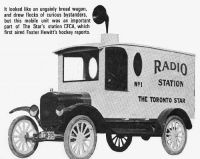CFCA-AM, CFCA-AM, Toronto
The Toronto Daily Star / Left the air
| Station | Year | Freq. | Power | Owner/Info |
|---|---|---|---|---|
| CFCA-AM | 1933 | n/a | n/a | The Toronto Daily Star / Left the air |
| CFCA-AM | 1928 | 770 kHz | 100 | The Toronto Daily Star |
| CFCA-AM | 1922 | 400 metres | 100 | The Toronto Daily Star |
Circa late 1921

Joseph E. Atkinson, owner of the Toronto Daily Star, knew of progress in wireless from his son’s hobby (call 3EC) and was interested in the promotional value of The Star’s being the first newspaper in Canada to broadcast voice and live music.
Arrangements were made secretly with Canadian Independent Telephone Company, Toronto, to broadcast a Star Concert over CITCo’s experimental station 9AH. The Star had been presenting frequent free “live” concerts for the public, and arranged for this first radio concert to be received by the public in the Masonic Temple and at the Christie Street Military Hospital.
Ernest Bushnell started in radio as a singer on CFCA.
March 28, 1922
First concert broadcast at 8:30 p.m. from the CITCo studio in the General Electric factory at Wallace Avenue and Ward Street. The power was 100 watts and the wavelength 450 metres. Artists included Luigi Romanelli’s Orchestra, cellist Boris Hambourg, pianist Alberto Guerrero and violinist Henri Czaplinski. CITCo’s Dr. Charles A. Culver announced, produced and directed all aspects of the broadcast.
April 4, 1922
The success of the first broadcast concert was so great that a series was arranged and, in all, CITCo broadcast 19 Star concerts, the last airing on June 14, 1922.
April 10, 1922
The first of The Star’s daily programs were broadcast from 7:00 to 7:30 p.m. on 450 metres. The format included a financial bulletin, sports, a guest speaker or musician, a children’s bedtime story and a political bulletin telegraphed from The Star’s correspondent in Ottawa.
June 12, 1922
First of two 80-foot reinforced steel towers completed on roof of The Star Building. Antenna was a five-wire flat-top T-antenna, 200 feet long.
June 22, 1922
Grand opening of CFCA (wavelength 400 metres), located in a couple of small rooms in The Star Building, 18-20 King Street West. The station was designed and built by Dr. Culver and his CITCo staff, using a CITCo 2-kW transmitter. CITCo also outfitted the Star’s little white roving radio van. Announcer and operator was former ham E.J. Bowers.
1922
Kathleen Wilson (Betty Lee) joined CFCA.
1923
On February 8th, 1923, CFCA introduced play-by-play hockey broadcasts, when Toronto Star sports reporter Norman Albert called the third period of an OHA intermediate game at the Mutual Street Arena. As did all hockey games broadcast during that era on CFCA, it began around 9:45 pm with a rinkside summary of the first two periods followed by a play-by-play description of the third period.
On February 16th, with only a few hours notice, Foster Hewitt was given his first hockey broadcast assignment . . . to handle that evening an amateur senior game between the Toronto Argonauts and the Kitchener Greenshirts. He did the broadcast using an ordinary telephone of the era, cramped inside an improvised 4′ x 4′ glass booth at ice level. The game went into 3 periods of overtime, and the broadcast lasted 3 hours. For a long time, the sports broadcasting facilities were crude and uncomfortable. Foster would help set up the booth – often in an unsafe place to get the best viewpoint.
1924
In February, at the request of Canadian Press, CFCA broadcast the first news service to provincial newspapers when a storm destroyed telephone and telegraph communications.
CFCA studios moved to Yonge Street and St. Clair Avenue
May, 1925
Foster Hewitt broadcast one of the first horse races from Woodbine track.
1925
CFCA experimented with remote control broadcasting, bringing in the Champlain Tercentenary celebration from Orillia by long-distance telephone.
1925-26
Jim Montagnes moved from the Toronto Star to CFCA as announcer-operator.
1927
Former ham Gordon W. McLean succeeded Bowers as announcer and chief engineer.
James Montagnes joined CFCA and worked alongside Foster Hewitt.
February 9, 192
CFCA was one of the first stations in North America to re-broadcast short wave from Europe – from 2LO, London; two weeks later a program from Australia; then a speech by the Prince of Wales, from London.
1928
After years of sharing its frequency with two other stations, CFCA using 100 watts was awarded a separate frequency at 770 Kcs. enabling it to lengthen its broadcast schedule.
CFCA installed new transmitting equipment to narrow its wave band.
Arthur D. “Cowboy” Kean joined the CFCA staff. In April, Jim Montagnes moved on to freelance work.
September 1st,
CFCA ceased to broadcast. Mr. Atkinson was convinced that the Canadian government was going to set itself up a broadcasting monopoly and take over private stations.
Undated
Gord McClain managed CFCA for seven years. He joined CKCL in 1924, moved to CFCA and then went back to CKCL.
Years after CFCA was gone – 1947 – J. E. Atkinson of the Toronto Daily Star – applied for a Toronto FM licence. The FM application was put off later by Atkinson.
When Joseph Atkinson (Toronto Star, ex-CFCA-AM) died in 1948 it was said several thousand shares of SRL (CFRB) were found in his safe. He closed his CFCA-AM in 1933 (opened in 1922) because he was apparently convinced radio was a passing fad. His shares in SRL were acquired by a holding company headed by E.P. Taylor, whose Argus Corp. had quietly held effective control of SRL ever since.
The story continues elsewhere…
Effective September 1st 2019, we will only be adding new material to these station histories in exceptional circumstances. Our intent to chronicle the early days of these radio and television stations has been achieved, and many new sources and technologies, from the CRTC website to Wikipedia, and others, are now regularly providing new information in these areas.
